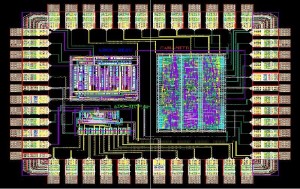In this blog post, Hitender Sharma, a member of the Bar of the District Court Mandi Town, Himachal Pradesh and currently pursuing a Diploma in Entrepreneurship Administration and Business Laws from NUJS, Kolkata, writes a note on the Semiconductor Integrated Circuit Layout Design (SICLD) Act, 2000.
Semiconductor Integrated Circuit Layout Design (SICLD) Act, 2000
Semiconductor Integrated Circuit Layout Design(SICLD) Act, 2000, has come into operation in India w.e.f. 4th September 2000. As per the provisions of this Act, Registrar Semiconductor Integrated Circuits Layout-Design Registry under the Ministry of Electronics and Information Technology (MeitY) has been appointed with its head office at Electronics Niketan, 6 CGO Complex, Lodi Road New Delhi-110003.The Registry maintains the Register of Layout-Designs and records in it the registered layout-designs with the names, addresses, and descriptions of the proprietor and such other matters related to the registered layout-designs.
Procedure for Registration of Layout design
Acceptance of Application
Any person who wants to register his layout-design is required to apply in writing to the Registrar Semiconductor Integrated Circuits Layout-Design Registry in the concerned territorial jurisdiction, as per the procedure prescribed in the SICLD Act, 2000.
The Registrar after scrutiny may refuse the application or may accept it absolutely or with amendments or modifications, as he may consider necessary.
Prohibition of registration of certain layout-designs
The SICLD Act, 2000 prohibits the registration of certain Layout designs. Layout design which is not original is prohibited. Similarly, the registration of layout design which has been commercially exploited anywhere in India or a convention country has been prohibited. Layout design which is not inherently distinctive or which is not inherently capable of being distinguishable from any other registered layout-design also cannot be registered. The Act, however, provides that a layout-design which has been commercially exploited for not more than two years from the date on which an application for its registration has been filed either in India or a convention country shall be considered as not having been commercially exploited.
According to SICLD Act, 2000, layout-design is to be considered as original if it is the result of its creator’s intellectual efforts and is not commonly known to the creators of layout-designs and manufacturers of semiconductor integrated circuits at the time of its creation. The Act further provides that a layout-design consisting of such combination of elements and interconnections that are commonly known among creators of layout-designs and manufacturers of semiconductor integrated circuits shall be considered as original if such combination taken as a whole is the result of its creator’s intellectual efforts. Furthermore, this Act provides that where an original layout-design has been created in execution of a commission or a contract of employment, the right of registration to such layout-design shall belong, in the absence of any contractual provision to the contrary, to the person who commissioned the work or to the employer.
Withdrawal of acceptance
As per provisions of SICLD Act, 2000, the Registrar has the power to withdraw the acceptance of an application for registration (before registration of layout design) if it comes to his knowledge that the layout-design is prohibited of registration under the provisions of this Act.The Registrar may however, provide the opportunity of being heard to the applicant if he so desires, before the withdrawal of the acceptance.
Advertisement of application
According to SICLD Act, 2000, when an application for registration of a layout-design has been accepted, the Registrar is bound to advertise the accepted application within fourteen days after the date of acceptance. After the advertisement, the Registrar has the discretion to advertise the application again if the application has been corrected or is permitted to be amended under the Act and notify in the prescribed manner the correction or amendment made.
Opposition to registration
Any person under the SICLD Act, 2000 can oppose the proposed registration of layout design. After an application for registration of a layout-design has been accepted, any person can give notice in writing to the Registrar of his opposition, within three months from the date of advertisement or re-advertisement or within further period not exceeding one month in the aggregate, ( as may be allowed by the Registrar ) as per the procedure provided .
The Registrar is required to serve a copy of the notice to the applicant for registration. The applicant for registration may send a counter-statement of grounds on which he relies, within two months of the receipt of notice of opposition and if he does not do so, he shall be deemed to have abandoned his application. The Registrar shall send a copy of the counter-statement of the grounds to the person giving notice of opposition. Both the applicant and the opponent may also submit any evidence relied upon to the Registrar if they so desire. If the applicant for registration or the opponent sending notice of opposition neither resides nor carries on business in India, the Registrar may require them to give security for the costs of proceedings before him and, in default may treat the opposition or application, as the case may be, as abandoned. The Registrar then decides the matter regarding the registration based on the material before him. The application for registration is treated as abandoned if it is not completed within 12 months due to the reason of default on the part of the applicant or within such extended time as may be allowed by the Registrar.
Registration
According to the SICLD Act, 2000, Registrar shall register the layout-design in the register, if the application has not been opposed within the prescribed time limit or the application has been opposed and the opposition has been decided for the applicant. The date of making the application is considered to be the date of registration of layout-design. After registration, the Registrar issues certificate of registration sealed with the seal of the Semiconductor Integrated Circuits Layout-Design Registry. Registration gives exclusive rights to the creator of layout-design for 10 years. It enables him to exploit the creation commercially and in the case of infringement, get reliefs permitted under the Act. Once the layout design is registered, the original registration and all subsequent assignments and transmissions of layout-design are admissible as a prima facie evidence of its validity. It cannot be held invalid on the ground that it was not a registerable layout design except upon evidence of originality and if such evidence was not submitted to the Registrar before. The Act confer all the powers of a civil court to the Registrar for the purposes of receiving evidence, administering oaths, enforcing the attendance of witnesses compelling the discovery and production of documents and issuing commissions for examination the of witnesses. It can also refer disputes to the Appellate Board.
Duration of registration
As per SICLD Act, 2000, the registration of a layout-design is done only for ten years w.e.f. from the date of filing an application for registration or from the date of first commercial exploitation anywhere in India or any country, whichever is earlier.
Infringement of layout-design
Only a registered proprietor of the layout-design or a registered user can make use the layout design. What will constitute the infringement of layout design has been explained in detail in the SICLD Act, 2000. Under the Act any person who infringes the layout design shall be liable to pay the proprietor of the registered layout-design, royalty to be determined by negotiation between registered proprietor and that person or by the Appellate Board. Such royalty is negotiated keeping in view the benefit that accrued to the person who has infringed the layout design as per the SICLD Act, 2000. The users/purchaser of infringed layout design is entitled to the immunity from infringement under this Act. Use of registered layout-design with the written consent of the registered proprietor of a registered layout-design also shall not constitute infringement. Also, where any person creates a layout design by application of independent intellect which is identical to a registered layout-design, then, such act shall not constitute infringement of the registered layout-design.
Assignment and transmission of registered layout-design
The proprietor of a registered layout-design has powers under the Act to assign the layout-design for any consideration. The registered layout-design may be transferred with or without good will. However, the person who becomes entitled by assignment or transmission to a registered layout-design shall also have to register his title with the Registrar as per the procedure provided in the Act.
Use of registered layout-design by registered users
When registered layout-design is intended to be allowed to be used by some other person, then such person is required to be registered with the Registrar as registered user. Registered proprietor and the proposed registered user shall have to make a joint application in writing to the Registrar in a prescribed manner along with agreement in writing (or a authenticated copy ) , entered into between them with regard to use of layout design showing particulars of the relationship, existing or proposed, including the degree of control by the proprietor over the permitted use which this relationship will confer. The particulars should also clarify whether the proposed registered user shall be sole registered user and mention the place and duration of permitted use. After getting the compliance of requirements under the Act, the Registrar registers the proposed registered user.
The Registrar has powers under the Act to cancel the registration as a registered user of layout design on some of the following grounds:
- registered user has not used the layout-design in accordance with the agreement
- the proprietor or the registered user misrepresented, or failed to disclose some material facts at the time of application which would have an adverse bearing on the registration of the registered user
- the circumstances have changed since the date of registration in such a way that at the date of such application for cancellation they would not have justified registration of the registered user
- that the registration ought not to have been effected having regard to right vested in the applicant by a contract in the performance of which he is interested
- registration may be canceled by the Registrar of his motion or on the application in writing by any person on the ground that any stipulation in the agreement between the registered proprietor and the registered user regarding the topographical dimensions of the layout design is either not being enforced or is not being complied with
- registration may be canceled by the Registrar if the layout-design is no longer registered
The Registrar is required to issue notice in respect of every application received for cancellation of registration of registered user to the registered proprietor and each registered user (not being the applicant) of the layout-design. However, before canceling of registration, the registered proprietor shall be given a reasonable opportunity of being heard.
Thus, it would be seen that the SICLD Act, 2000 Act has been enacted to provide for the protection of Intellectual Property of semiconductor integrated circuits layout-designs and matters connected therewith or incidental thereto. It defines layout-designs of integrated circuits which can be registered under the Act. It also defines the rights conferred by registration of layout-designs. It clarifies as to what constitute an infringement of layout design. It also provides for a penalty for infringement of layout designs. It almost covers all aspects of protecting intellectual property rights of semiconductor integrated circuits layout-designs.
 Serato DJ Crack 2025Serato DJ PRO Crack
Serato DJ Crack 2025Serato DJ PRO Crack














 Allow notifications
Allow notifications


